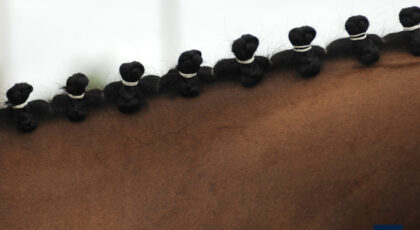Sometimes finding the distance to a jump or seeing your spot on course is just downright frustrating. The ability flickers in and out like lights in a thunderstorm, occasionally leaving you and your horse in the dark. Renowned coach Jen Marsden Hamilton says it doesn’t have to be this way! She has traveled the world teaching striding on course to hunters, jumpers, and eventers, from youngsters to Olympians. In her book Stride Control, she explains how a little bit of the right practice at home can help you nail the distance, every time.
***
When on course in competition, there is no time to think, there is only time to assess the situation and make adjustments to follow your strategy. Thinking is done at home. Once a skill is a habit, you don’t have to focus on it.
You walk the jumping course to build a strategy. It is your responsibility as a rider to ride the track and set up the stride/pace on the short side of the arena for what’s required in the line of jumps ahead.
God made the horse under the Imperial System, and God said the horse shall have a 12-foot stride (at least in North America!) Courses and related lines are based on the 12-foot stride. A 60-foot line of jumps will ride as four 12-foot strides, leaving one 12-foot increment as the space required for landing and takeoff (6 feet each).

Setting Pace
In order to get around lower-level courses, you need three different canters: regular canter (middle), open canter (forward or longer stride), and closed canter (steady or shorter stride). It is the rider’s responsibility to set and maintain stride length and pace. All lines do not ride the same, and riders and horses need to learn and like jumping off different stride lengths and different distances/takeoff points.
Factors to be considered when setting stride (pace):
- Actual measurement between jumps—is the distance long, short, or lovely?
- Types of jumps—vertical to oxer, oxer to vertical, vertical to vertical?
- Where the line is on course—is it first or last?
- How close the jump is to a turn—the jump takes away pace when combined with a short turn.
- Whether the jump is toward or away from the in-gate.
- What kinds of distractions are present.
Set the pace, keep the pace, and let the jump come to you.
PRACTICE THIS EXERCISE:
For this exercise you need two ground poles, 60 feet apart on the long side of the arena.

Use a tape measure and measure from both ends of the poles to ensure they are parallel and the right distance apart. It also pays to mark the position of the poles with cones or a pair of jump wings. This way you will notice if the horse knocks a pole and alters the distance.
Stride control between the poles is longitudinal work (back to front). In contrast, serpentines and turn-on-the-forehand (for example) are lateral work (side to side). This exercise does both.
Strategy
1. Canter the two poles with five strides between them—this is your regular (middle) canter.
2. Ride a serpentine of three loops—canter the first loop, trot the second loop, and canter the third loop, making all your transitions on the centerline.
3. Halt on the centerline and turn on the forehand to change the rein.
4. Canter around the arena and canter the two ground poles in five strides again.
5. Ride a serpentine of three loops again, this time trotting the first loop, cantering the second loop, and trotting the third loop.
6. Walk on the centerline.
Purpose
The purpose of this exercise is to teach:
- The rider to take responsibility for setting up, on the short side of the arena, the stride length required in the line, which is determined by the distance between the ground poles (longitudinal work).
- The rider to organize and turn, and straighten and turn, as she rides the serpentine (lateral work).
- Both rider and horse discipline and accuracy in the transitions (longitudinal work).
- The rider coordination of aids and the horse to yield or move off the pressure of one leg aid in the turn-on-the-forehand (lateral work).
- The rider to think and organize. Cantering down the long side may seem like an empty task; it isn’t. The transition to trot on the centerline, and the start of the serpentine, is a good test for this.
- To finish the ride neatly with a downward transition to walk on the centerline on completion of the serpentine.

This excerpt from Stride Control by Jen Marsden Hamilton is reprinted with permission from Trafalgar Square Books (www.horseandriderbooks.com).


 November 12, 2020
November 12, 2020 

























